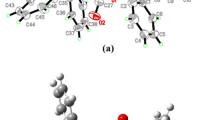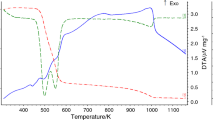Abstract
The thermal behaviour of complexes of the type M(HIm)2ac2 (HIm=imidazole,ac=acetate,M=Co, Ni, Cu) is different. Comparable to the thermal degradation of Ni(acac)2(HIm)2 [10] the Ni(HIm)2ac2 loss acetic acid by formation of Ni(Im)2. All nitrogen ligands are splitt off from the copper complex by formation of stable basic copper acetate. The cobalt compound eliminated acetic acid partially while acetate and imidazolate bridging species are obtained.
The thermal behaviour of the acetate complexes of pyrazole and the bulky 3,5-dimethylpyrazole is quite similar. In a first step pyrazoliumacetate is removed.
The crystal structure of Ni(HPz)4ac2 is determined by X-ray diffraction: monocline, space group C 2/c.
The water molecule represents the centre of two N−H...O−H...O-bridges. The system of H-bridges in the compound relieves the proton transfer, indicated by the elimination of pyrazolium acetate.
Zusammenfassung
Komplexverbindungen des Typs M(HIm)2ac2 (HIm=Imidazol,ac=Acetat,M=Co, Ni, Cu) zeigen ein differenziertes thermisches Verhalten. Der thermische Abbau der Nickelverbindung erfolgt analog dem Ni(acac)2(HIm)2 [10] unter Freisetzung von Essigsäure und Bildung von Ni(Im)2. Der Kupferkomplex apaltet alle stickstoffhaltigen Liganden unter Ausbildung stabiler basischer Kupferacetate ab. Die Cobaltverbindung elininiert thermisch teilweise Essigsäure, sodaß stabile acetat- bzw. imidazolatverbrückte Species entstehen.
Die Pyrazol- bzw. die sterisch anspruchsvollen 3,5-Dimethylpyrazol-komplexe zeigen ein untereinander vergleichbares Verhalten, wobei in einem ersten Schritt jeweils Pyrazoliumacetat freigesetzt wird.
Die Kristalstruktur von Ni(HPz)4ac2 wurde durch Röntgenbeugung bestimmt: monoklin, Raumgruppe C2/c.
Die Verbindung besitzt ein ausgeprägtes Wasserstoffbrückensystem mit einem Wassermolekül als Zentrum zweier N−H...O−H...O-Brücken, wodurch der leichte Protonentransfer unter Abspaltung von Pyrazoliumacetat verständlich wird.
Similar content being viewed by others
References
R. J. Doedens, Prog. Inorg. Chem., 21 (1976) 209.
M. Melnik, Coord. Chem Rev., 36 (1981) 1.
M. Kato and Y. Muto, Coord. Chem. Rev., 92 (1988) 45.
R. Österberg, Coord. Chem Rev., 12 (1974) 309.
R. G. Bhirud and T. S. Srivastava, Inorg. Chem. Acta 173 (1990) 121.
A. Dobry-Duclaux and A. May, Bull. Soc. Chim. Biol., 52 (1970) 1447.
H. Tamura, H. Imai, J. Kuwahara and Y. Suguira, J. Am. Chem. Soc., 109 (1987) 6870.
M. Fedtke and V. Strehmel, Acta Polymer, 40 (1989) 997.
A. Böttcher, M. Döring, E. Uhlig, M. Fedtke, K. Dathe and B. Nestler, PCT-Patent 1991, WO 91/13925 vom 19.09.1991.
M. Döring, W. Ludwig, M. Meinert and E. Uhlig, Z. Anorg. Allg. Chem., 595 (1991) 45.
M. Döring, W. Ludwig, E. Uhlig, S. Wocadlo and U. Müller, Z. Anorg. Allg. Chem. 611 (1992) 61.
A. Gadet, Acta Crystallogr., B30 (1974) 349.
H. Å. Henriksson, Acta Crystallogr., B33 (1977) 1947.
A. Gadet, C. R. Acad. Sci., Paris, Sér., C 274 (1972) 263.
A. L. Abuhijleh and C. Woods, Inorg. Chim. Acta, 194 (1992) 9.
A. L. Abuhijleh, C. Woods and I. Y. Ahmed, Inorg. Chim. Acta, 190 (1991) 11.
S. Trofimenko, Chem. Rev., 72 (1972) 497.
M. Inoue, M. Kishita and M. Kubo, Inorg. Chem., 4 (1965) 626.
C. W. Reimann, A. D. Mighell and F. A. Mauer, Acta Crystallogr., 23 (1967) 135.
C. W. Reimann, J. Chem. Soc., Chem. Comm., 1969 145.
W. Ludwig, J. Thermal Anal., 8 (1975) 75.
MOLEN, An Interactive Structure Solution Procedure, Enraf-Nonius, Delft, The Netherlands 1990.
G. M. Sheldrick, SHELXS, Programm zur Lösung von Kristallstrukturen, Göttingen 1980.
G. M. Sheldrick, SHELXTL/PC, Siemens Analytical X-ray Instruments, Inc., Madison WI 1992.
R. J. Sundberg, B. Martin, Chem. Rev., 74 (1974) 471.
W. Eilbeck, F. Holmes and S. Underhill, J. Chem Soc., A (1967) 757.
Gmelin's Handbuch der Anorganischen Chemie, 8. Auflage B60 2.Lfg. Verlag Chemie, Weinheim 1961, p. 697.
J. Reedijk, Recl. Trav. Chim. Pays-Bas, 91 (1972) 507.
S. J. Ashcroft and C. T. Mortimer, ‘Thermochemistry of Transition Metal Complexes’, Academic Press, New York 1970.
Author information
Authors and Affiliations
Rights and permissions
About this article
Cite this article
Döring, M., Ludwig, W. & Görls, H. Thermal latent coordination compounds. Journal of Thermal Analysis 42, 443–459 (1994). https://doi.org/10.1007/BF02548527
Issue Date:
DOI: https://doi.org/10.1007/BF02548527




